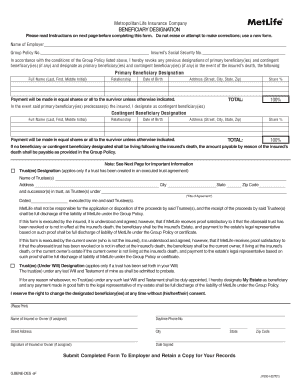Fill and Sign the Metlife Insurance Forms

Useful Advice for Finishing Your ‘Metlife Insurance Forms’ Online
Are you fed up with the annoyance of handling documents? Look no further than airSlate SignNow, the leading e-signature solution for individuals and small to medium-sized enterprises. Bid farewell to the monotonous tasks of printing and scanning files. With airSlate SignNow, you can effortlessly finalize and endorse documents online. Make use of the robust functionalities integrated into this user-friendly and cost-effective platform and transform your method of document administration. Whether you require form approvals or need to collect signatures, airSlate SignNow manages it all seamlessly, with just a few clicks.
Adhere to this detailed guide:
- Log into your account or sign up for a complimentary trial with our service.
- Select +Create to upload a document from your device, cloud storage, or our template library.
- Open your ‘Metlife Insurance Forms’ in the editor.
- Click Me (Fill Out Now) to prepare the form on your end.
- Add and designate editable fields for others (if needed).
- Continue with the Send Invite settings to solicit eSignatures from others.
- Download, print your copy, or convert it into a reusable template.
Don't worry if you need to collaborate with others on your Metlife Insurance Forms or send it for notarization—our platform provides you with everything necessary to accomplish such tasks. Register with airSlate SignNow today and take your document management to new levels!
FAQs
-
What are Metlife Insurance Forms and how can airSlate SignNow help?
Metlife Insurance Forms are essential documents required for various insurance processes. airSlate SignNow streamlines the completion and signing of these forms, ensuring a hassle-free experience for both agents and customers. With our user-friendly platform, you can easily send and eSign Metlife Insurance Forms, signNowly reducing processing time.
-
How does airSlate SignNow ensure the security of Metlife Insurance Forms?
At airSlate SignNow, security is a top priority. We implement advanced encryption technologies to protect your Metlife Insurance Forms during transmission and storage. Additionally, our platform complies with industry standards, ensuring that your sensitive information remains confidential.
-
Can I integrate airSlate SignNow with my existing systems for handling Metlife Insurance Forms?
Yes, airSlate SignNow offers seamless integrations with various CRM and management systems. This allows you to efficiently manage your Metlife Insurance Forms alongside your other business processes. Our integration capabilities enhance workflow efficiency and ensure a smoother experience.
-
What pricing plans are available for using airSlate SignNow with Metlife Insurance Forms?
airSlate SignNow provides flexible pricing plans tailored to meet the needs of businesses of all sizes. You can choose a plan that best fits your volume of Metlife Insurance Forms and overall usage. Our cost-effective solutions ensure you receive value without compromising on features.
-
What features does airSlate SignNow offer for managing Metlife Insurance Forms?
airSlate SignNow includes features such as customizable templates, bulk sending, and real-time tracking for your Metlife Insurance Forms. These features simplify the document management process, allowing for quick modifications and updates as needed. You can also automate reminders for signatures to keep your workflow on track.
-
Is there customer support available for issues related to Metlife Insurance Forms?
Absolutely! airSlate SignNow provides dedicated customer support to assist you with any issues regarding Metlife Insurance Forms. Whether you need help with document setup, signing, or technical support, our team is here to ensure a smooth experience for you.
-
How can airSlate SignNow improve the turnaround time for Metlife Insurance Forms?
By utilizing airSlate SignNow, you can signNowly reduce the turnaround time for Metlife Insurance Forms. Our electronic signing feature allows users to sign documents instantly from anywhere, eliminating the delays associated with traditional paper forms. This efficiency helps expedite your insurance processes.
Related searches to metlife insurance forms
Find out other metlife insurance forms
- Close deals faster
- Improve productivity
- Delight customers
- Increase revenue
- Save time & money
- Reduce payment cycles

